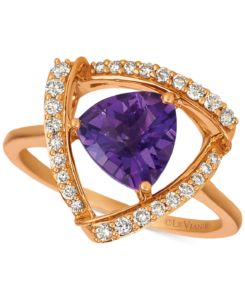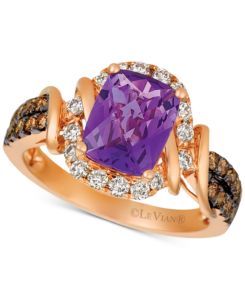No quartz variety has been more sought after than the amethyst. Its dashing purple flair, considered the color of royalty, made it the gem of choice amongst the nobility. Today, its abundance and affordability have made the amethyst one of the most popular alternative gems for engagement rings. Chic yet traditional, it is regal and glamorous. A picture may speak a thousand words, but an amethyst ring expresses more than you could ever say about just how deep the rivers of your love run for your partner.
The amethyst comes in different shapes and sizes. Though now coveted for engagement or promise rings, it was not always the case. Up until the 19th century, the amethyst was available only to the upper classes of society because it was as expensive as the ruby or the emerald. In the past, kings, princes, and religious leaders greatly desired it. Even today, an Amethyst is used in Catholic Bishops’ rings. It is prized highly among celebrities: Alicia Keys famously wore an amethyst and diamond ring to the 2009 Academy Awards, while Zoe Saldana wore a white and yellow gold amethyst ring to the 2012 Vanity Fair Oscar Party.
Harriet Forbes wrote in her 1924 book Mystic Gems, “The amethyst colors of red and blue, making violet, are symbols of power and light. The deep violet color stands for true and deep love.” Its robust purple hue certainly sends the heart racing. An amethyst ring sings a song of steadfast strong love, the kind that they write poems and tell stories about, signaling a deep bond between you and your partner that will last a lifetime.
Let us take a closer look at what you should consider about its desired properties.
How important is color when selecting an amethyst ring?
Amongst the quartz species, the amethyst is the purple variety. Even though there are other purple gems such as sapphires and tanzanites, the amethyst is most famously connected to the color purple. Its glassy sheen varies from transparent to opaque, its hues ranging from cool light lilac to dark vibrant violet. It goes beautifully with different metals and several settings, strengthening its popularity.
Even though the amethyst is purple, it can sometimes be confused with prasiolite, a semi-precious pale green form of heat-treated quartz incorrectly referred to as ‘green amethyst’. Remember, purple is the only proper kind of amethyst.
Due to its natural formation, the amethyst comes in color layers or “stripes”. This can affect the price. The most valued gems have strong tones from vivid reddish-purple to dark purple, while any visible tints or lighter colors can reduce its value.
When picking the stone for your engagement ring, be sure to check that the color is free from rust-colored or brown tints. If it is too dark, it can appear as black under certain lighting conditions. Do browse through all the options before handing over your money: amethyst’s ready availability means there will always be a good amethyst gem out there to find!
How important is clarity for amethyst?
Like in diamonds, clarity matters. There is a high demand for intense-colored stones with minor inclusions. Lighter-colored gems with visible inclusions are valued less. Yet, if a vibrant amethyst gem with eye-visible inclusions is cut correctly, such as a cabochon, it can still make for a good looking amethyst ring.
 How do enhancements affect amethyst and its pricing?
How do enhancements affect amethyst and its pricing?
Treatments and enhancements are only used on two occasions: to reduce a stone’s inclusions and enhance its color, or to transform it into a different type of gem. Heat treatment can turn an extremely dark amethyst stone into a lighter shade of purple. It also turns purple quartz into citrine or green quartz (not to be confused with ‘green amethyst’).
However, treatments are rarely used with amethyst. Unless the stone is quite dark, there is a risk of losing the original shade of violet altogether. Ask the jeweler about treated crystals when you go shopping, for there is little to no difference when it comes to an untreated amethyst’s pricing.
How to choose the carat size for your amethyst ring?
Amethyst comes in all sizes and is ideal for setting in a ring. Since quartz is plentiful, it can be cut into gems weighing anything from 1 carat to thousands of carats, though clean amethysts of 100 carats or more are rare.
A small stone has the same elegance as a large one. You should base your decision about the size on the amethyst’s robust hues and what your partner likes.
What is the best cut and shape for an amethyst?
The amethyst is versatile. It can be cut into a mix of standard shapes such as round, oval and emerald as well as cabochon, cameo, mixed, pendeloque and step. It can also be cut in a custom design so if you have an idea for a one-of-a-kind piece in mind, then choose an amethyst. You can read more about the different shapes and cuts available.
If you are taking your first step towards a serious commitment, you can delight your partner with a custom-designed amethyst promise ring. It is a creative choice for a lively engagement ring.
One stone or accent stones?
Since the price per carat does not increase with size, you can opt for a single large center stone for your ring while remaining within budget. This opens up a host of creative possibilities for accent stones to assemble a truly stunning amethyst ring. Diamond accent stones set rich purple amethysts ablaze. If you choose other colored gems as accent stones, pair those that coordinate or contrast with violet. Pink or blue sapphires will match wonderfully, and opals and pearls can add luster. Your options are endless!
 Which metal goes best with amethyst?
Which metal goes best with amethyst?
The color purple catches the eye immediately. When set in a ring, amethyst pairs marvelously with all types of metal. Warm metals such as gold and yellow gold enhance and magnify the gem’s rich shades of deep violet. Cooler metals such as platinum, silver and white gold bring out the blue undertones within. No matter the type, an amethyst ring will always give its wearer a graceful nobility. Your choice, therefore, depends on what suits your partner best.
How to care for your amethyst ring?
As a type of quartz, amethyst ranks 7 on the Mohs scale. It is a durable stone, capable of withstanding regular wear. You can safely clean your ring using warm soapy water. However, avoid subjecting it to heat. If your ring comes with softer side stones, keep in mind that they might be scratched more easily from an active lifestyle, so be sure to read up on their cleaning guidelines, too. If treated with proper care, an amethyst ring can last you a long time.
How much does an amethyst ring cost?
What is so appealing about the amethyst is that you would not have to pay more per carat. This will free up your budget, so let loose your imagination. That is why unlike with most other colored gems, the cost and worth of an amethyst ring depend more on the setting, design, and metal type. Hence, a single amethyst in silver can be as low as $50 or $100. An amethyst in platinum or gold, with or without diamond accent stones, might cost you anywhere from $400 to $2,000. Meanwhile, customizable rings are approximately $300 to $3,000. This variety also makes it a great birthday gift for someone special.
The more complex your setting, the more you’ll have to spend. That’s why you should ensure you do your research to identify what you and your partner want before you ever step inside a shop.
An amethyst ring is a popular alternative, especially if purple is your partner’s favorite color. It is also the February birthstone, so if they celebrate their birthday that month, then you should certainly pick it. It is a bold statement, symbolizing a powerful and loving partnership.
